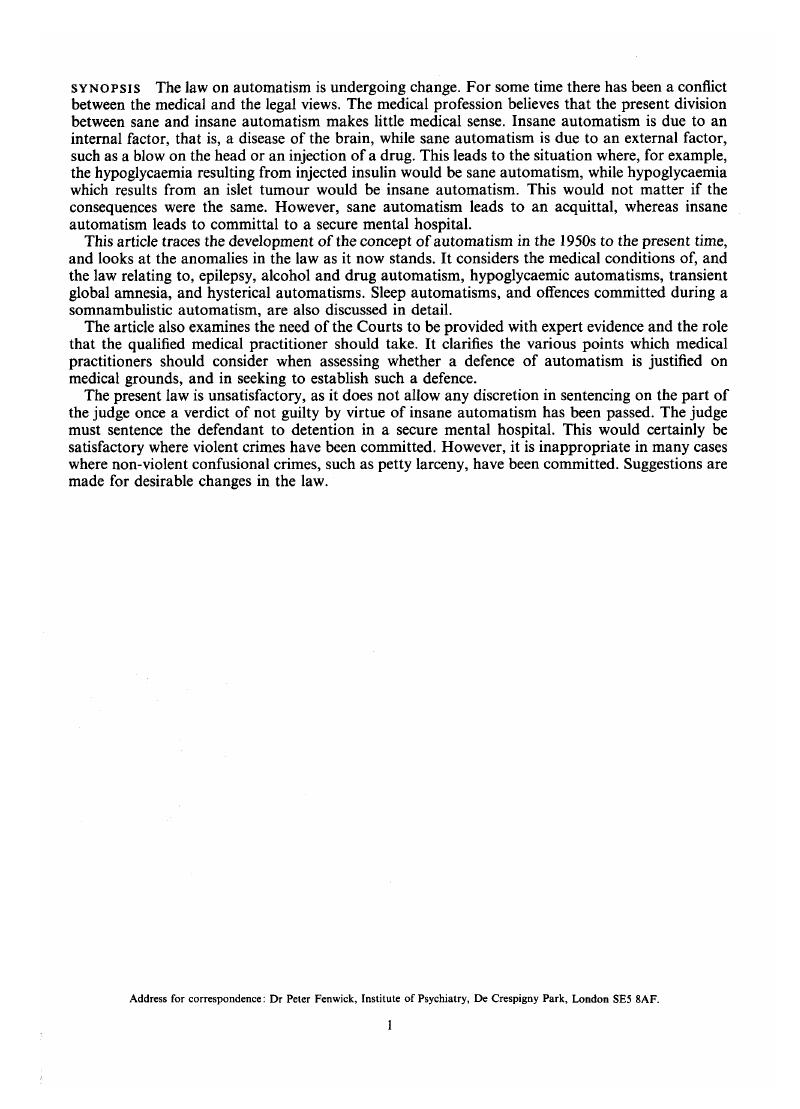Crossref Citations
This article has been cited by the following publications. This list is generated based on data provided by Crossref.
Kellam, Alexander M. P.
1991.
Medicine and the law.
Psychiatric Bulletin,
Vol. 15,
Issue. 2,
p.
96.
Beran, Roy G
1993.
Automatisms—The Gulf Between Medicine and the Law.
Australian Journal of Forensic Sciences,
Vol. 25,
Issue. 2,
p.
66.
Wright, N
Elfer, D
and
Wright, I
1995.
Automatism Re-Visited: Post-Traumatic Automatism as a Defence to a Serious Criminal Charge.
Medicine, Science and the Law,
Vol. 35,
Issue. 4,
p.
327.
Schenck, Carlos H
and
Mahowald, Mark W
1998.
An Analysis of a Recent Criminal Trial Involving Sexual Misconduct with a Child, Alcohol Abuse and a Successful Sleepwalking Defence: Arguments Supporting Two Proposed New Forensic Categories.
Medicine, Science and the Law,
Vol. 38,
Issue. 2,
p.
147.
Bartholomew, Robert E.
1999.
The Conspicuous Absence of a Single Credible Case of Latah-Related Death or Serious Injury.
Transcultural Psychiatry,
Vol. 36,
Issue. 3,
p.
369.
Mahowald, Mark W.
and
Schenck, Carlos H.
1999.
MEDICAL–LEGAL ASPECTS OF SLEEP MEDICINE.
Neurologic Clinics,
Vol. 17,
Issue. 2,
p.
215.
Marks, Vincent
and
Teale, J. Derrick
1999.
HYPOGLYCEMIA: FACTITIOUS AND FELONIOUS.
Endocrinology and Metabolism Clinics of North America,
Vol. 28,
Issue. 3,
p.
579.
Mahowald, Mark W.
and
Schenck, Carlos H.
2000.
Parasomnias: sleepwalking and the law.
Sleep Medicine Reviews,
Vol. 4,
Issue. 4,
p.
321.
McCrory, P
2001.
The medicolegal aspects of automatism in mild head injury.
British Journal of Sports Medicine,
Vol. 35,
Issue. 5,
p.
288.
Ebrahim, Irshaad O.
and
Shapiro, Colin M.
2001.
The Parasomnias and Other Sleep-Related Movement Disorders.
p.
81.
Levy, Neil
and
Bayne, Tim
2004.
Doing without deliberation: Automatism, automaticity, and moral accountability.
International Review of Psychiatry,
Vol. 16,
Issue. 3,
p.
209.
Jordan, W.
and
Rüther, E.
2005.
Verhandlungsfähigkeit bei Schlafstörungen.
Rechtsmedizin,
Vol. 15,
Issue. 3,
p.
156.
Mahowald, Mark W.
and
Schenck, Carlos H.
2005.
Principles and Practice of Sleep Medicine.
p.
960.
Mahowald, Mark W.
Schenck, Carlos H.
and
Bornemann, Michel A. Cramer
2005.
Sleep-related violence.
Current Neurology and Neuroscience Reports,
Vol. 5,
Issue. 2,
p.
153.
Kaido, Takanobu
Otsuki, Taisuke
Nakama, Hideyuki
Kaneko, Yuu
Kubota, Yuichi
Sugai, Kenji
and
Saito, Osamu
2006.
Complex behavioral automatism arising from insular cortex.
Epilepsy & Behavior,
Vol. 8,
Issue. 1,
p.
315.
Cramer Bornemann, Michel A.
Mahowald, Mark W.
and
Schenck, Carlos H.
2008.
Sleep Medicine.
p.
240.
Ebrahim, Irshaad
and
Fenwick, Peter
2008.
Letter to the Editor re: Pressman et al. Alcohol‐induced sleepwalking or confusional arousal as a defense to criminal behavior: a review of scientific evidence, methods and forensic considerations. J. Sleep Res. (2007) 16, 198‐212.
Journal of Sleep Research,
Vol. 17,
Issue. 4,
p.
470.
Mahowald, Mark W.
and
Schenck, Carlos H.
2009.
Sleep Disorders Medicine.
p.
654.
Mahowald, Mark W.
Schenk, Carlos H.
and
Cramer Bornemann, Michel A.
2011.
Sleep Disorders.
Vol. 99,
Issue. ,
p.
1149.
Katz, Douglas I.
2011.
Encyclopedia of Clinical Neuropsychology.
p.
328.





